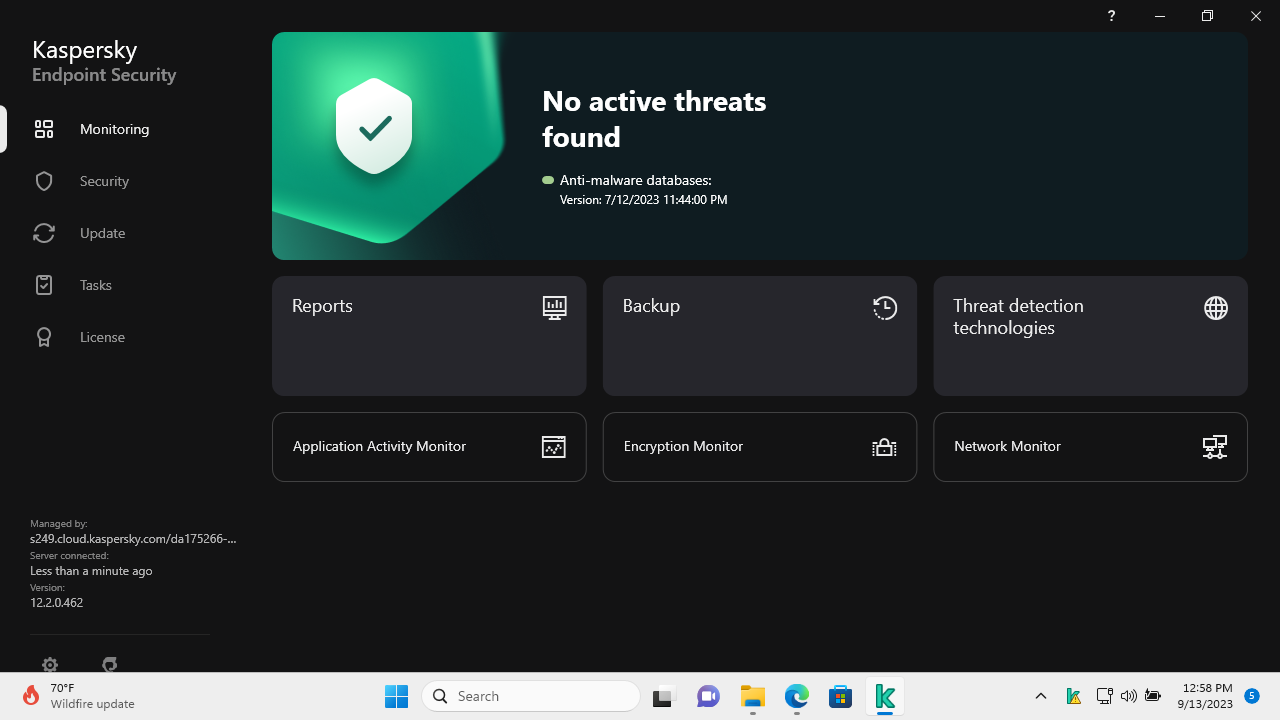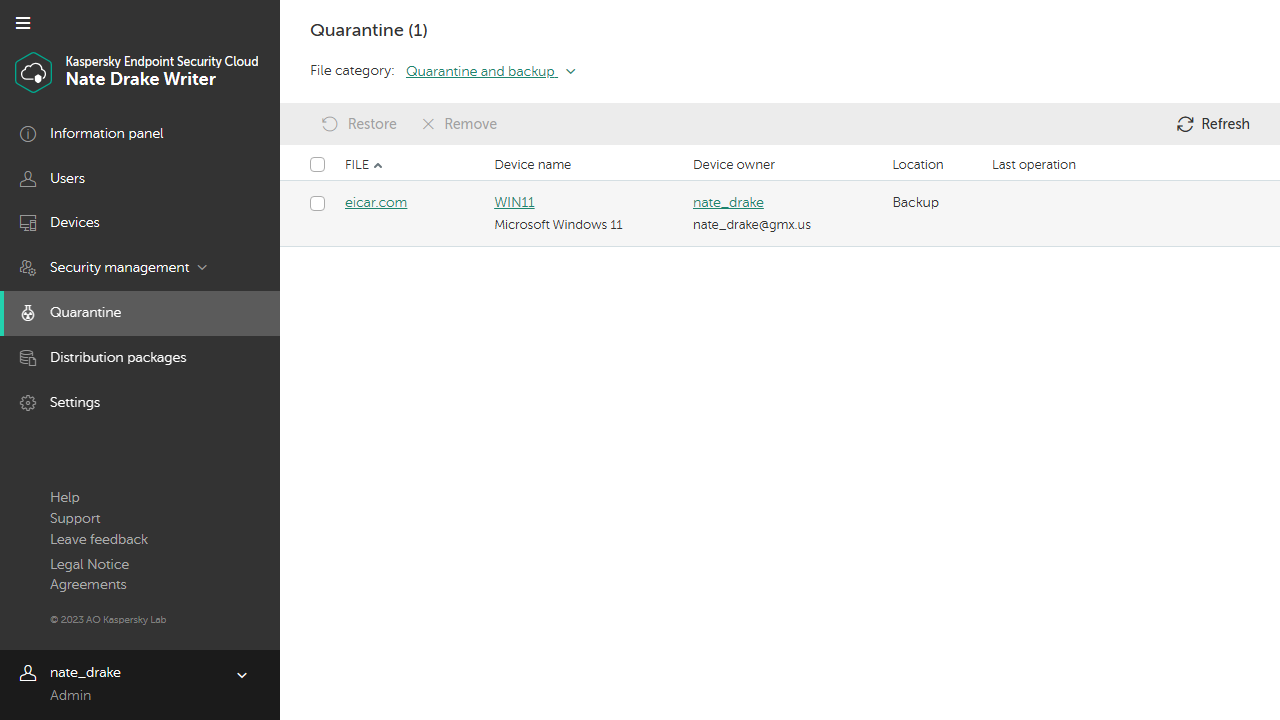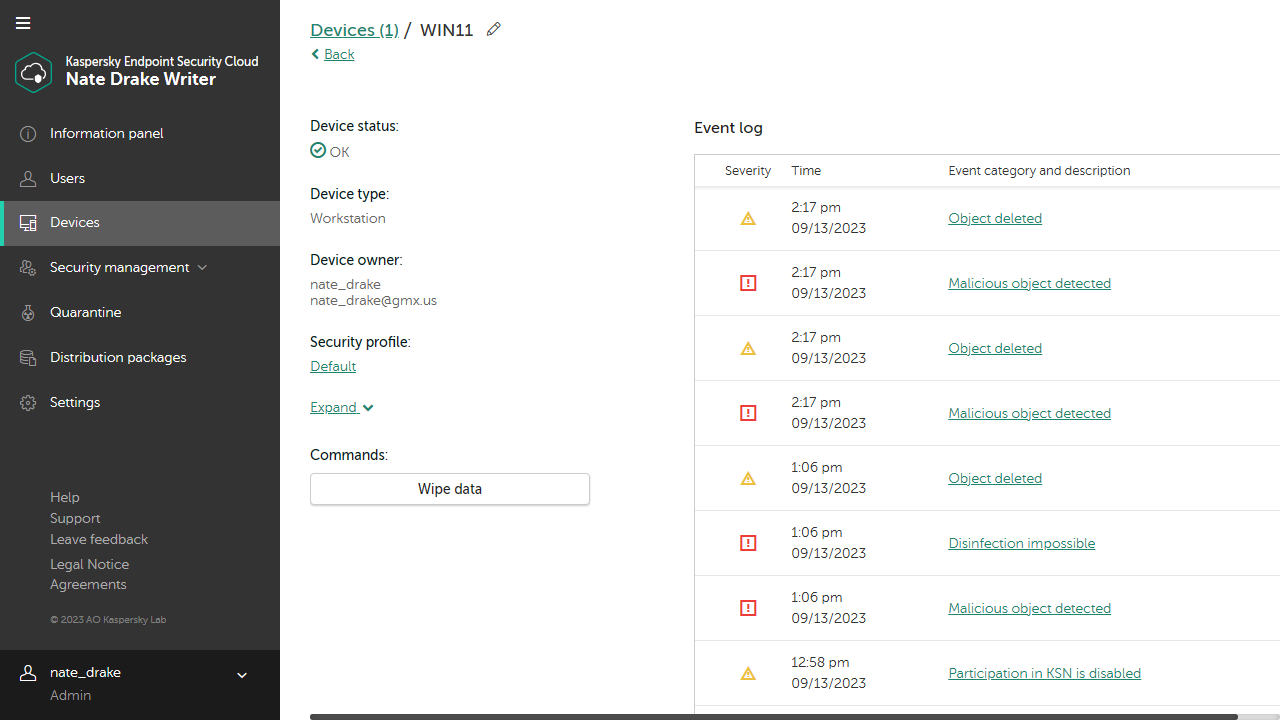TechRadar Verdict
Kaspersky has done it again. Endpoint Security Cloud Pro takes moments to register, deployment is simple and there's a Swiss-army knife of security features. Pricing is also clearly explained and there's a free trial. What more could you want?
Pros
- +
Guided setup
- +
Intuitive UI
- +
Powerful agent software
Cons
- -
Slightly imperfect threat detection
Why you can trust TechRadar
Kaspersky is a big name in cybersecurity. Since 1997 the UK-based Russian company has been producing respectable security software. Although perhaps best known for itsincredbily powerful antivirus software, the company is currently the fifth largest vendor of Endpoint Protection.
Back in 2013, Kaspersky Endpoint Security Cloud won the AV-TEST Award for Best Protection 2012 but we couldn't help but wonder : has Kaspersky rested on their laurels or is it still one of the best endpoint security software platforms?
Kaspersky Endpoint Security Cloud: Plans and pricing
Unlike many other endpoint security platforms we've reviewed, Kaspersky's product page has a clearly laid out pricing model.
The lowest priced tier is for Kaspersky Endpoint Security Cloud - prices start from $215 per year for up to five devices. This includes file, web, mail and threat protection as well as ransomware prevention with 'rollback' features. There's also a 'Cloud Discovery' tool to monitor unauthorized use of cloud services and time wasted on social networks/messaging apps.
As we'd expect, the basic tier also includes a vulnerability scan to automatically patch applications.
The next pricing plan is 'Endpoint Security Cloud Plus', which starts at $342.50 per year for up to five devices.
This includes all of the above 'plus' root cause analysis with a visual kill chain, allowing managers to analyze attacks in more detail. Subscribers also benefit from web/device control, which allows greater control of endpoint user resources, as well as which USB devices can be connected.
Sign up to the TechRadar Pro newsletter to get all the top news, opinion, features and guidance your business needs to succeed!
The 'Plus' tier also includes better cloud management services, including limiting inappropriate use of cloud apps, as well as managing Microsoft 365 services. Vulnerability patching is automatic and this pricing plan also supports OS encryption.
Endpoint Security Cloud Pro is the highest-priced tier and is the one on which this review is based. Prices start at $550 per year for up to 5 devices.
All tiers also support up to two mobile devices (Android or iOS) per user.
All the above plans are available as a free 30-day trial, with no payment information required upfront. All interested parties need to do is create a free account with Kaspersky Business Solutions.

Kaspersky Endpoint Security Cloud: Features
Kaspersky Security Cloud Pro contains all the features listed in the lower two pricing tiers such as basic file, web, mail and threat protection. The agent software also has firewall features.
This tier provides EDR (Endpoint Detection and Response), including automated responses to known threats. We were also impressed to see 'Pro' subscriptions also include cybersecurity training for IT administrators.
The developers have produced a detailed datasheet on everything else the platform has to offer. Chief advantages include the fact that its very flexible, supporting Windows, macOS, Android and iOS. Endpoints can also be managed from a single cloud console, saving organizations the time and resources of self-hosting.
Although we'll delve into the interface in more detail, while we're talking about the cloud we were impressed to see that the dashboard and other aspects of the UI can be customized through various web widgets. This makes it much easier for network managers only to see the information they see as vital.

Kaspersky Endpoint Security Cloud: Setup
As we mentioned, the best way to try out Kaspersky Endpoint Security Cloud is through creating a free account with the Kaspersky Business Hub. You're then offered a chance to try out Endpoint Security Cloud or Kaspersky Security for Microsoft Office 365.
Simply enter your company information and agree to the terms and conditions to have the platform create a dedicated workspace.
On first login, we were delighted to see a welcome wizard which provided some useful tips on managing devices through creating security profiles.
The setup wizard also suggests using various Endpoint Security Cloud features including EDR mode, as well as 'Cloud Discovery Mode'. The second of these can monitor and block unwanted cloud services.
By default the platform will scan for vulnerabilities once a week, though we were able to amend this to daily scans.
When the console first appeared, we were shown a helpful 'Information Panel' of other tasks to perform to get the best endpoint protection. These include reviewing which features are enabled, as well as links to 'add users' and 'add devices'.
We accessed 'Distribution Packages' and began downloading Kaspersky Security Endpoint for Windows to our test machine. The installer was a hefty size (over 300MB) but we later saw this was justified, given its features and graphical interface.
The install wizard took around 2 minutes to complete, and was immediately able to run an update to download new threat definitions.

Kaspersky Endpoint Security Cloud: Interface
When reviewing endpoint security platforms, we often gloss over the agent program as it's usually little more than an icon sitting in the system tray.
In the case of Kaspersky Security Endpoint for Windows however, clients are treated to a visual feast. The main 'Monitoring' section displays a quick summary of threats found (if any), plus there's an excellent rundown of all threat detection technologies.
While the agent was updating itself, we took the opportunity to log in to the Kaspersky Cloud Console. We skipped past the 'Information Panel' to the 'Devices' section using the handy bar along the left hand pane.
Our test device was listed here, along with key information like the device name and owner. Clicking into the device displays more key information such as the status, security profile and event log.
Our only minor criticism of the UI is that users cannot download the agent software for devices from here but instead need to go to 'Distribution Packages'. Otherwise the interface is extremely intuitive and easy to navigate.

Kaspersky Endpoint Security Cloud: Performance
Having updated Kaspersky Security Endpoint for Windows, we were keen to put the platform through its paces.
When reviewing endpoint security platforms, our first test is to try to download a fake computer virus, provided by the good people of EICAR.
We opened the Edge browser on our test machine and downloaded the file in compressed (ZIP) format. When we tried to extract the file, we found the fake virus vanished from the folder. The agent software didn't display a notification but when we visited the comprehensive 'Reports' section of the Kaspersky cloud console we saw the file had, in fact, been quarantined.
For our next test, we tried to copy a new, real computer virus to our test machine's "Downloads" folder. We do this to check if an endpoint security platform can detect threats based on a file's behavior, not just by comparing it to a known database of suspicious signatures.
Sadly, Kaspersky didn't fare so well in this test. When we copied the file, the agent didn't react. We next right-clicked the file and had Kaspersky Security Endpoint scan it, only for it to report that no threats were found. Finally we ran the file - at this point Microsoft Defender stepped in to quarantine it but there was no report of this on the Kaspersky Cloud Console.
This is troubling, especially given that virtually every other endpoint security platform we've reviewed has detected this trojan virus immediately or at the very least when we tried to run it.
We decided to give Kaspersky the benefit of the doubt and tried to download another new trojan virus. This time the agent software immediately detected and quarantined it as soon as we opened the folder it contained.

Kaspersky Endpoint Security Cloud: Final Verdict
We've said previously that Kaspersky are a big name in cybersecurity and their endpoint security software has won multiple awards. Given how simple it is for organizations to register a business account and try out the cloud console, we can see why.
The helpful wizards which display on first login make device deployment a breeze and as we've learned the platform is available for both Windows, macOS and mobile devices. We were disappointed not to see Linux support but that's par for the course with most endpoint security solutions these days.
The array of security features is also spectacular : file scanning is combined with e-mail analysis and a firewall. The cloud security features also make it much easier to prevent unauthorized apps from hogging system resources.
While we're talking security, we can't ignore that Kaspersky Security Endpoint failed to detect a virus in one of our tests. However it did detect and quarantine our 'fake' virus immediately and then did the same for another real trojan we introduced to the test machine. In fairness, no endpoint security platform claims to detect and prevent every type of threat.
In the case of those the agent did spot though, we'd have appreciated a pop up notification to tell us the threat had been contained. As it was, we simply saw the files vanished and had to log in to the cloud console for verification.
This said, the interface itself is very well laid out and easy to navigate. We also greatly appreciate the transparent pricing structure and how easy it is to set up a free trial, meaning you have nothing to lose by testing out this platform for yourself.
We've listed the best cloud firewall.
Nate Drake is a tech journalist specializing in cybersecurity and retro tech. He broke out from his cubicle at Apple 6 years ago and now spends his days sipping Earl Grey tea & writing elegant copy.
